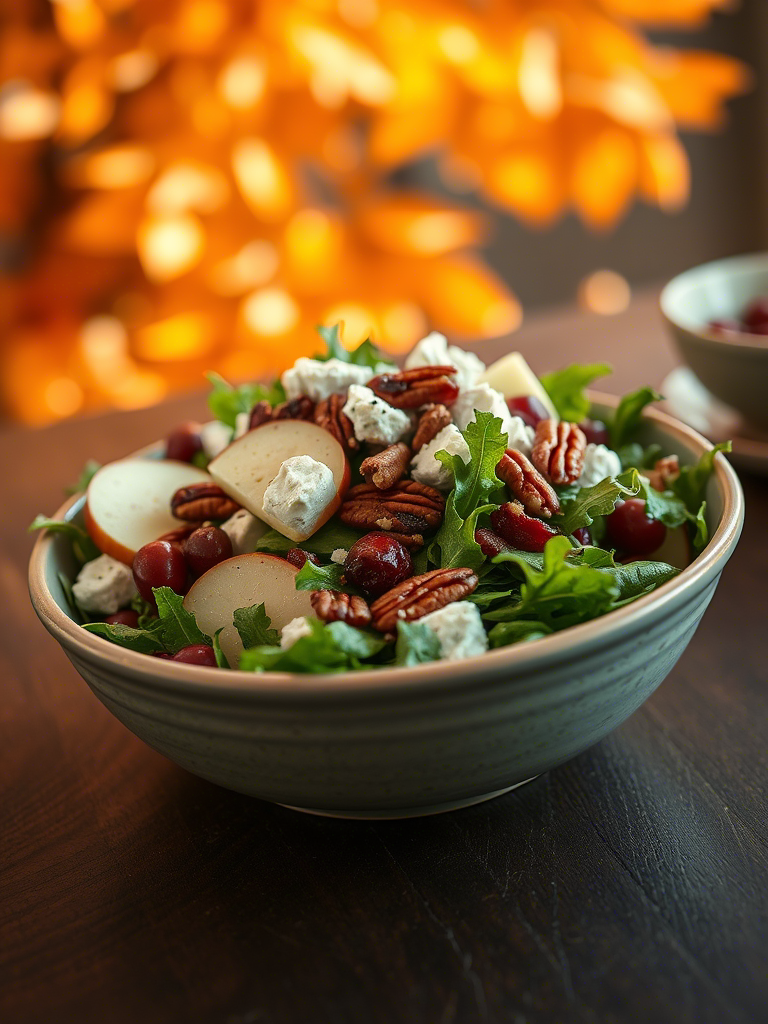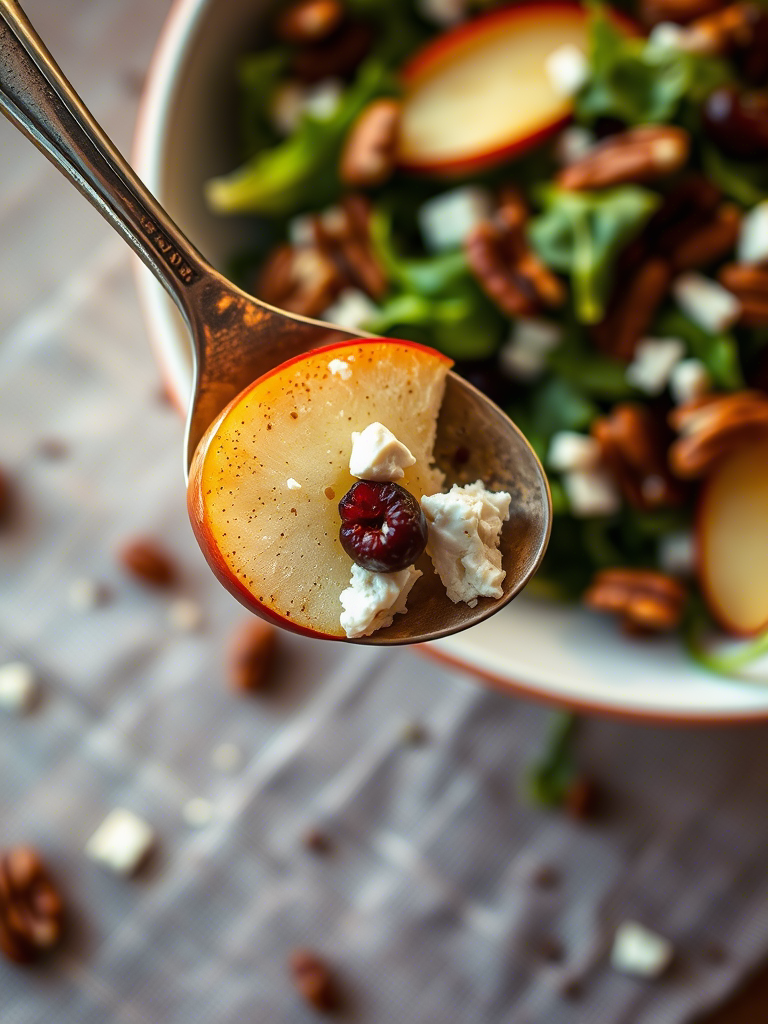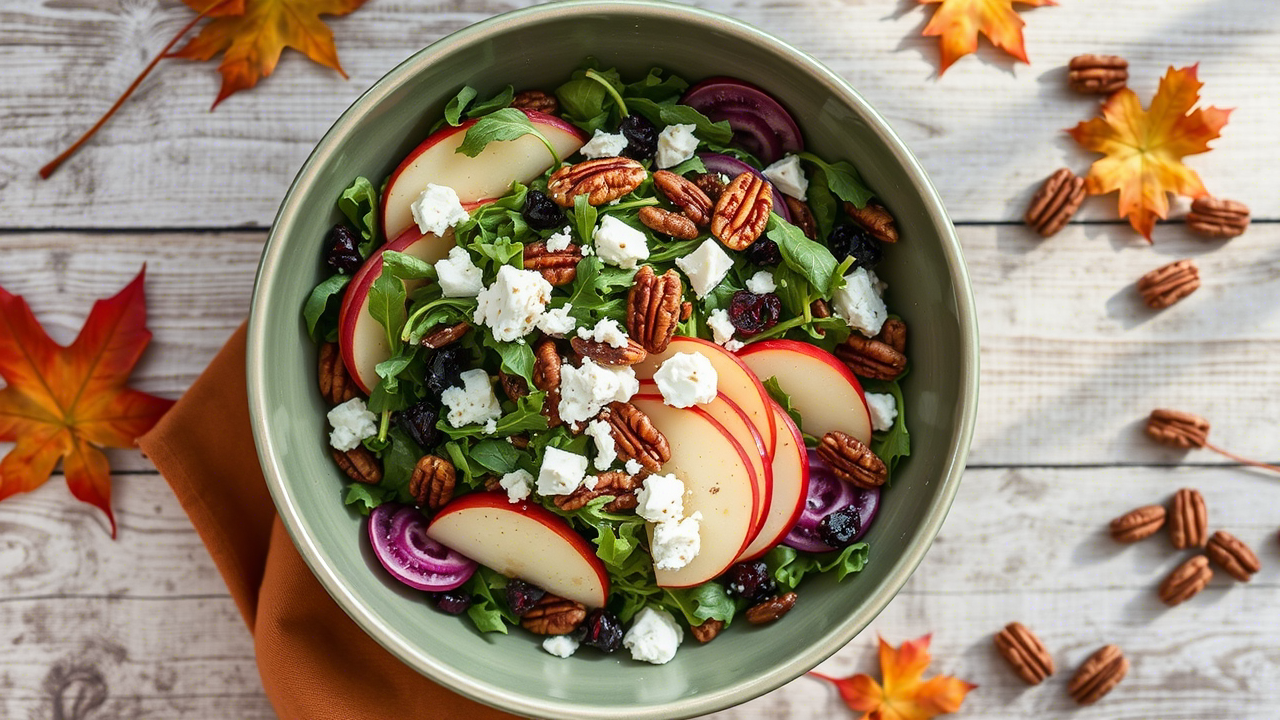There’s something oddly satisfying about biting into a crisp Honeycrisp apple while standing in a cold kitchen with socks too thin for tile. That’s autumn. And in the world of culinary expression, fall’s harvest opens a window—one dripping with golden sunlight and the smell of damp leaves—for ingredients to shine without being too flashy. Enter: the Autumn Harvest Honeycrisp Apple and Feta Salad.
Now this ain’t your everyday green bowl. It’s a marriage of crunch, salt, tart, sweet, and creamy that, when done right, borders on art.
But not everyone does it right.
This article dives deep—not just how to make it, but why it works, and how to elevate this seasonal dish to something worthy of a white plate in a Michelin-level bistro. Whether you’re a line cook, a home chef dreaming big, or just someone tired of limp romaine drowning in ranch, you’re in for a crisp surprise.
Why This Salad Works: The Science Behind the Crunch
Let’s talk sensory mechanics for a sec. The Honeycrisp apple didn’t just show up one day in a crate—this varietal was born outta careful breeding at the University of Minnesota in the ‘60s. What makes it wild is its unique cell structure. Bigger cells than your average apple, so when you bite, the cells rupture dramatically—cue the satisfying crunch.
That crunch doesn’t just feel good—it makes the sweetness hit harder. Pair that with the tang of feta, a crumbly Greek cheese aged in brine, and you get a sharp contrast in both flavor and texture. Sweet vs salty. Creamy vs crisp. Fresh vs aged. It’s a duet.
Then you’ve got your leafy greens. We’re not tossing in iceberg here. Think baby arugula, frisée, maybe even some shredded lacinato kale if you’re feelin’ bold. Bitterness here doesn’t dull the sweetness; it tempers it, lets it breathe.
Professionals call this “ingredient dialogue.” Everything speaks. Nothing screams.
Ingredient Deep Dive: Selecting with Intention
Honeycrisp Apples:
Don’t sub these out. Just don’t. Gala? Too soft. Fuji? Too sweet. Granny Smith? You’re veering into sourland. Honeycrisp offers that rare sweet-tart equilibrium, plus texture. Look for firm apples with no soft spots, ideally from local orchards. Cold storage apples from the grocery? They’ll do in a pinch, but they ain’t the same.
Feta Cheese:
Not all feta is equal. The real stuff—PDO-certified—comes from Greece and is made with sheep’s milk or a combo of sheep and goat. Cow’s milk versions lack that assertive tang and creamy crumble. Avoid pre-crumbled feta. It’s often dry and coated with anti-caking agents. Buy it in a block, stored in brine. Cut or crumble it yourself.
Greens:
Balance is key. Arugula adds peppery notes. Baby spinach brings softness. Kale gives chew. Mix ‘em or pick one depending on the tone you’re setting. For banquets or fine dining, go with a composed arugula base. For rustic lunches? Toss in everything.
Toasted Nuts (optional but c’mon):
Pecans. Walnuts. Even hazelnuts. Toast them briefly—not burned—just until fragrant. This adds fat, depth, and an earthy note that grounds the fruitiness.
Dressing:
Skip heavy cream dressings. This salad screams for something light, acidic, and maybe a tad sweet. Think maple-mustard vinaigrette. Or apple cider vinegar with a splash of fresh lemon juice, Dijon, and extra virgin olive oil. Finish with a drizzle of wildflower honey if you’re chasing fall vibes hard.

Culinary Pairings and Use Cases
What makes this salad a chef’s secret weapon is versatility.
As a Starter:
Serve in a chilled shallow bowl. Dress greens lightly, top with shaved apple (cut on a mandoline), crumbled feta, and nuts arranged just so. Add a few microgreens if you’re feeling dramatic.
Main Course Upgrade:
Top with pan-seared chicken thighs (skin-on, salt-forward), or roast duck breast sliced thin. For vegetarians, roasted butternut squash cubes add weight and warmth.
Catering Note:
Hold the dressing until serving. Apples oxidize fast. Soak slices in acidulated water (water + lemon juice) for a few minutes if prepping ahead.
Wine Pairing Tip:
Dry Riesling, unoaked Chardonnay, or a light-bodied Pinot Noir. Apples and feta can overwhelm delicate wines, so go with something that’s got acidity and minerality.
Nutritional Profile: What’s Really On Your Plate?
Here’s what a single serving (about 1½ cups) roughly offers:
- Calories: 250–350 (depending on nuts and dressing)
- Protein: 6–9g (from feta and nuts)
- Fat: 18–22g (mostly healthy fats from oil and nuts)
- Fiber: 4–6g
- Sugar: 10–14g (naturally from apples)
There’s no ultra-processed anything. And that matters, especially in a foodservice environment pivoting towards whole food, clean label trends. Consumers want fresh, seasonal, and Instagrammable—and this dish hits all three.
Tips for Prep at Scale
In a professional kitchen, speed and consistency matter.
- Mandolines save time and ensure apple slices are uniform.
- Cold storage your greens immediately after wash/dry to preserve perky texture.
- Pre-portion feta into deli cups to streamline plating.
- Label apple bowls with time-prepped tags. Even acid-dipped slices have a short shelf life.
- Batch your dressing in squeeze bottles and shake before each use to re-emulsify.
It’s these small practices that separate a chaotic lunch rush from a service that feels like a dance.
Common Mistakes and How to Dodge ‘Em
Mistake 1: Overdressing the salad.
Greens should be glistening, not soggy. Use just enough vinaigrette to coat. Better under than over.
Mistake 2: Too thick apple slices.
Thick cuts lose the elegance and balance. They also overpower bites. Go thin—think translucent but not floppy.
Mistake 3: Using bad feta.
Dry, rubbery feta ruins the whole experience. Spring for the real stuff and treat it right. Store it submerged in brine.
Mistake 4: Serving warm.
Cold salad. Cold apples. Room temp nuts. Nothing worse than wilting greens from residual heat.
Mistake 5: Ignoring the salt balance.
Feta brings brine. Dressing might have salt. Nuts could be salted too. Taste before final salt sprinkle—otherwise, you’ll go from elegant to overkill.

Emerging Trends: Where This Salad Is Headed
Watch for additions like pomegranate seeds, roasted delicata squash, or even crispy prosciutto. Salads are going maximalist again—layered textures, varied temps, bold contrasts. But don’t lose the integrity of this combo.
In high-end catering, composed salads are seeing a revival. Instead of a tossed bowl, think rows or layers of ingredients, plated with tweezers. Yes, tweezers. Ridiculous, but oddly satisfying.
Also, plant-based cheeses are improving. A whipped almond “feta” with lemon juice and miso can mimic the salt-fat pop of real feta for vegan clients. Texture’s not quite the same, but flavor gets close.
Real-World Applications
At Farm-to-Table Restaurants:
Highlight the salad on a chalkboard menu. Source apples and honey locally. Mention it. Customers love hyper-local.
At Corporate Lunch Events:
Serve in mason jars or compostable bowls. Keeps it neat and photogenic.
At Home for the Food Nerds:
Try spiralizing the apple. Looks funky. Toss in some dried cranberries and a crack of black pepper. You’ll thank yourself later.
Final Thoughts: Why This Salad Sticks With You
The Autumn Harvest Honeycrisp Apple and Feta Salad isn’t just seasonal fare. It’s an edible snapshot of October—the crunch of leaves, the early dark, the comfort of bold flavors with clean finishes.
It’s refined and rustic all at once.
Professionals love it for its structure. Home cooks love it for its soul. And if you do it with care—real care, not the performative kind—it becomes something more than lunch.
It becomes a memory.
So go on. Get the apples cold, your knife sharp, your feta briny, and build a bowl that tastes like the best parts of fall.
And maybe, just maybe, don’t forget the socks next time you’re on cold tile.
FAQs
What type of apple is best for this salad?
Honeycrisp apples are ideal for their perfect sweet-tart balance and signature crisp texture.
Can I substitute the feta cheese with another cheese?
Yes, goat cheese or blue cheese work, but they’ll change the flavor profile significantly.
How do I keep the apple slices from browning?
Soak them briefly in lemon water to slow oxidation before adding to the salad.
What dressing works best for this salad?
A light vinaigrette with apple cider vinegar, Dijon mustard, and a touch of honey is best.
Can I make this salad ahead of time?
You can prep ingredients ahead, but combine and dress just before serving for freshness.
Is this salad suitable for vegans?
Use plant-based feta alternatives and skip honey to make it fully vegan-friendly.
What proteins pair well with this salad?
Grilled chicken, roasted duck, or even pan-seared tofu elevate it to a main dish.
What greens are best to use?
A mix of arugula, spinach, and baby kale provides the best flavor and texture contrast.
Should the salad be served cold or room temperature?
Always serve it cold to keep the greens crisp and the apple slices fresh.
Can I add other fruits or toppings?
Yes, pomegranate seeds, roasted squash, or toasted nuts add flavor and visual interest.
Ask ChatGPT

Mariana is a passionate home cook who creates delicious, easy-to-follow recipes for busy people. From energizing breakfasts to satisfying dinners and indulgent desserts, her dishes are designed to fuel both your body and hustle.
When she’s not in the kitchen, she’s exploring new flavors and dreaming up her next recipe to share with the Foodie Hustle community.

